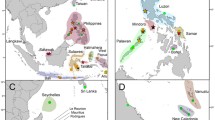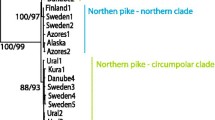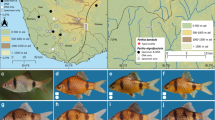Abstract
To reveal the primary historical events that affected the geographic differentiation in freshwater organisms in the Japanese archipelago, we investigated the phylogeny and phylogeographic structure of the widely distributed freshwater fish Pseudogobio esocinus. We conducted comprehensive phylogeographic analyses based on partial sequences of the mitochondrial DNA cytochrome b (cyt b) gene in 1,212 P. esocinus specimens from 201 locations in 136 river systems along with sequence data from related species. We also examined the entire cyt b sequence and three nuclear gene sequences for a subset of individuals to estimate the phylogenetic relationships and divergence times. Historical processes shaping the present phylogeographic patterns were inferred by the Bayesian skyline plot, mismatch distribution and nested clade phylogeographic analyses. The mitochondrial and nuclear DNA phylogenies showed that the Japanese P. esocinus was not monophyletic and consisted of three largely differentiated groups. Divided by the Central Highlands, two groups were distributed in southwestern Japan, with a third group in northeastern Japan. The estimated divergence time indicated that the framework of the present ranges of the three groups was formed during or before the Early Pliocene. In southwestern Japan, the two groups often occurred sympatrically and included several regional subgroups bounded by major mountain systems uplifted in the early Pleistocene, while in the northeastern Japanese group, recent (since about 0.3 million years ago) range expansion from the northwestern area was inferred. The results suggest the importance of the uplifting of the Central Highlands and interconnection with the continental area in the distribution and divergence of P. esocinus, which may have also influenced regional heterogeneity in the Japanese freshwater fauna. The contrasting phylogeographic patterns between northeastern and southwestern Japan probably reflect their topographic and geohistorical differences, and imply differences in the formation process of freshwater fauna between the two regions.








Similar content being viewed by others
References
Aoyagi H (1957) General notes on the freshwater fishes of the Japanese archipelago. Taishukan, Tokyo
Avise JC (2000) Phylogeography: the history and formation of species. Harvard University Press, Cambridge
Beaumont M, Panchal M (2008) On the validity of nested clade phylogeographic analysis. Mol Ecol 17:2563–2565
Burridge C, Craw D, Fletcher D, Waters J (2008) Geological dates and molecular rates: fish DNA sheds light on time dependency. Mol Biol Evol 25:624–633
Clement M, Posada D, Crandall KA (2000) TCS: a computer program to estimate gene genealogies. Mol Ecol 9:1657–1659
Crandall KA, Templeton AR (1993) Empirical tests of some predictions from coalescent theory with applications to intraspecific phylogeny reconstruction. Genetics 134:959–969
Dowling T, Tibbets C, Minckley W, Smith G (2002) Evolutionary relationships of the plagopterins (Teleostei: Cyprinidae) from cytochrome b sequences. Copeia 2002:665–678
Drummond A, Rambaut A, Shapiro B, Pybus O (2005) Bayesian coalescent inference of past population dynamics from molecular sequences. Mol Biol Evol 22:1185–1192
Drummond AJ, Rambaut A (2007) BEAST: Bayesian evolutionary analysis by sampling trees. BMC Evol Biol 7:214
Drummond AJ, Suchard MA (2010) Bayesian random local clocks, or one rate to rule them all. BMC Biol 8:114
Excoffier L, Laval G, Schneider S (2005) Arlequin (version 3.0): an integrated software package for population genetics data analysis. Evol Bioinform Online 1:47–50
Fu YX (1997) Statistical tests of neutrality of mutations against population growth, hitchhiking and background selection. Genetics 147:915–925
Fujita J, Nakayama K, Kai Y, Ueno M, Yamashita Y (2011) Geographic distributions of mitochondrial DNA lineages reflect ancient directions of river flow: a case study of the Japanese freshwater shrimp Neocaridina denticulata denticulata (Decapoda: Atyidae). Zool Sci 28:712–718
Heled J, Drummond AJ (2010) Bayesian inference of species trees from multilocus data. Mol Biol Evol 27:570–580
Inami E (1951) The causes and process of river piracy in Japan. Geogr Rev Jpn 24:337–343
Jobb G (2008) TREEFINDER version of October 2008. Munich, Germany. http://www.treefinder.de. Accessed 4 October 2014
Kaizuka S, Chinzei K (1986) Mountains in Japan. Iwanami Shoten, Publishers, Tokyo
Kawabe T (1989) Stratigraphy of the lower part of the Kobiwako Group around Ueno basin, Kinki district, Japan. J Geosci Osaka City Univ 32:39–52
Kimizuka Y (1987) Spined loaches: zoogeography of karyological races. In: Mizuno N, Goto A (eds) The Japanese freshwater fishes: their distribution, variation and speciation. Tokai University Press, Tokyo, pp 61–70
Kitagawa T, Jeon SR, Kitagawa E, Yoshioka M, Kashiwagi M, Okazaki T (2005) Genetic relationships among the Japanese and Korean striated spined loach complex (Cobitidae: Cobitis) and their phylogenetic positions. Ichthyol Res 52:111–122
Kitagawa T, Watanabe M, Kitagawa E, Yoshioka M, Kashiwagi M, Okazaki T (2003) Phylogeography and the maternal origin of the tetraploid form of the Japanese spined loach, Cobitis biwae, revealed by mitochondrial DNA analysis. Ichthyol Res 50:318–325
Kitazima J, Matsuda M, Mori S, Kokita T, Watanabe K (2015) Population structure and cryptic replacement of local populations in the endangered bitterling Acheilognathus cyanostigma. Ichthyol Res 62:122–130
Knowles LL (2008) Why does a method that fails continue to be used? Evolution 62:2713–2717
Li CH, Orti G, Zhang G, Lu GQ (2007) A practical approach to phylogenomics: the phylogeny of ray-finned fish (Actinopterygii) as a case study. BMC Evol Biol 7:44
Lindberg GU (1972) Large-scale fluctuations of sea level in the quaternary period: hypothesis based on biogeographic evidence. Nauka, Lebubgrad
Machida H, Matsuda T, Umitsu M, Koizumi T (2006) Regional geomorphology of the Japanese Islands vol 5 Geomorphology of Chubu Region. University of Tokyo Press, Tokyo
Mihara M, Sakai T, Nakao K, Martins LD, Hosoya K, Miyazaki JI (2005) Phylogeography of loaches of the genus Lefua (Balitoridae, Cypriniformes) inferred from mitochondrial DNA sequences. Zool Sci 22:157–168
Mizuno N (1987) Formation of freshwater fish fauna in Japan. In: Mizuno N, Goto A (eds) Freshwater fishes of Japan: their distribution, variation and speciation. Tokai University Press, Tokyo
Nakajima T, Danhara T, Iwano H, Chinzei K (2006) Uplift of the Ou Backbone Range in Northeast Japan at around 10 Ma and its implication for the tectonic evolution of the eastern margin of Asia. Palaeogeogr Palaeoclimatol Palaeoecol 241:28–48
Nei M, Kumar S (2000) Molecular evolution and phylogenetics. Oxford University Press, New York
Nishimura S (1980) Origin of the Sea of Japan. Tsukijishokan, Tokyo
Okada A, Takahashi K (1969) Geographic development of the drainage basin of the River Yura, western Honshu, Japan. J Geogr 78:19–37
Ota Y, Naruse T, Tanaka S, Okada A (2004) Regional geomorphology of the Japanese Islands vol 6 Geomorphology of Kinki Region. University of Tokyo Press, Tokyo
Panchal M (2007) The automation of nested clade phylogeographic analysis. Bioinformatics 23:509–510
Pond SLK, Frost SDW, Muse SV (2005) HyPhy: hypothesis testing using phylogenies. Bioinformatics 21:676–679
Posada D, Crandall KA, Templeton AR (2000) GeoDis: a program for the cladistic nested analysis of the geographic distribution of genetic haplotypes. Mol Ecol 9:487–488
Rambaut A, Drummond AJ (2009) Tracer version 1.5. http://tree.bio.ed.ac.uk/software/tracer/. Accessed 7 July 2010
Rogers AR, Harpending H (1992) Population growth makes waves in the distribution of pairwise genetic-differences. Mol Biol Evol 9:552–569
Sakai H, Yamamoto C, Iwata A (1998) Genetic divergence, variation and zoogeography of a freshwater goby, Odontobutis obscura. Ichthyol Res 45:363–376
Setiamarga DHE, Miya M, Yamanoue Y, Azuma Y, Inoue JG, Ishiguro NB, Mabuchi K, Nishida M (2009) Divergence time of the two regional medaka populations in Japan as a new time scale for comparative genomics of vertebrates. Biol Lett 5:812–816
Shimizu T, Taniguchi N, Mizuno N (1993) An electrophoretic study of genetic differentiation of a Japanese freshwater goby, Rhinogobius flumineus. Jpn J Ichthyol 39:329–343
Shirai S, Yabumoto Y, Kim IS, Zhang CG (2003) Phylogeny of sinipercid fishes and their relatives inferred from mtDNA cytochrome b gene: a preliminary study. Bull Kitakyushu Mus Nat Hist Hum Hist, Ser A (Natural History) 1:45–49
Sota T, Hayashi M (2007) Comparative historical biogeography of Plateumaris leaf beetles (Coleoptera: Chrysomelidae) in Japan: interplay between fossil and molecular data. J Biogeogr 34:977–993
Suzuki T, Kitano T, Tojo K (2014) Contrasting genetic structure of closely related giant water bugs: phylogeography of Appasus japonicus and Appasus major (Insecta: Heteroptera, Belostomatidae). Mol Phylogenet Evol 72:7–16
Tajima F (1989) Statistical method for testing the neutral mutation hypothesis by DNA polymorphism. Genetics 123:585–595
Takahashi H, Takata K, Goto A (2001) Phylogeography of lateral plate dimorphism in the freshwater type of ninespine sticklebacks, genus Pungitius. Ichthyol Res 48:143–154
Takehana Y, Nagai N, Matsuda M, Tsuchiya K, Sakaizumi M (2003) Geographic variation and diversity of the cytochrome b gene in Japanese wild populations of Medaka, Oryzias latipes. Zool Sci 20:1279–1291
Tamura K, Dudley J, Nei M, Kumar S (2007) MEGA4: molecular evolutionary genetics analysis (MEGA) software version 4.0. Mol Biol Evol 24:1596–1599
Tanabe AS (2007) KAKUSAN: a computer program to automate the selection of a nucleotide substitution model and the configuration of a mixed model on multilocus data. Mol Ecol Notes 7:962–964
Templeton AR (1998) Nested clade analyses of phylogeographic data: testing hypotheses about gene flow and population history. Mol Ecol 7:381–397
Tominaga K, Watanabe K, Kakioka R, Mori S, Jeon SR (2009) Two highly divergent mitochondrial DNA lineages within Pseudogobio esocinus populations in central Honshu, Japan. Ichthyol Res 56:195–199
Watanabe K (2012) Faunal structure of Japanese freshwater fishes and its artificial disturbance. Environ Biol Fish 94:533–547
Watanabe K, Iguchi K, Hosoya K, Nishida M (2000) Phylogenetic relationships of the Japanese minnows, Pseudorasbora (Cyprinidae), as inferred from mitochondrial 16S rRNA gene sequences. Ichthyol Res 47:43–50
Watanabe K, Kawase S, Mukai T, Kakioka R, Miyazaki JI, Hosoya K (2010) Population divergence of Biwia zezera (Cyprinidae: Gobioninae) and the discovery of a cryptic species, based on mitochondrial and nuclear DNA sequence analyses. Zool Sci 27:647–655
Watanabe K, Nishida M (2003) Genetic population structure of Japanese bagrid catfishes. Ichthyol Res 50:140–148
Watanabe K, Takahashi H, Kitamura A, Yokoyama R, Kitagawa T, Takeshima H, Sato S, Yamamoto S, Takehana Y, Mukai T, Ohara K, Iguchi K (2006) Biogeographic history of Japanese freshwater fishes: phylogeographic approach and perspectives. Jpn J Ichthyol 53:1–38
Watanabe K, Mori S, Tanaka T, Kanagawa N, Itai T, Kitamura J, Suzuki N, Tominaga K, Kakioka R, Tabata R, Abe T, Tashiro Y, Hashimoto Y, Nakajima J, Onikura N (2014) Genetic population structure of Hemigrammocypris rasborella (Cyprinidae) inferred from mtDNA sequences. Ichthyol Res 61:352–360
Xia X, Zhang X, Liu H (2005) Phylogeography and speciation of Pseudogobio vaillanti in China: deep molecular divergence in the absence of morphological change. Prog Nat Sci 15:1064–1069
Yamazaki Y, Goto A, Nishida M (2003) Mitochondrial DNA sequence divergence between two cryptic species of Lethenteron, with reference to an improved identification technique. J Fish Biol 62:591–609
Yokoyama R, Goto A (2002) Phylogeography of a freshwater sculpin, Cottus nozawae, from the northeastern part of Honshu Island, Japan. Ichthyol Res 49:147–155
Yonekura N, Kaizuka S, Nogami M, Chinzei K (2001) Regional geomorphology of the Japanese Islands vol 1 Introduction to Japanese geomorphology. University of Tokyo Press, Tokyo
Yoshikawa N, Matsui M, Nishikawa K, Kim JB, Kryukov A (2008) Phylogenetic relationships and biogeography of the Japanese clawed salamander, Onychodactylus japonicus (Amphibia: Caudata: Hynobiidae), and its congener inferred from the mitochondrial cytochrome b gene. Mol Phylogenet Evol 49:249–259
Zardoya R, Doadrio I (1999) Molecular evidence on the evolutionary and biogeographic patterns of European cyprinids. J Mol Evol 49:227–237
Acknowledgments
We are very grateful to H. Sugiyama, T. Kusanagi, K. Iguchi, T. Natsumeda, N. Okabe, Y. Suzuki, T. Komiya, H. Yamane, T. Morosawa, H. Kumada, H. Takahashi and Y. Tanaka for helping sampling specimens. We also thank Y. Suzawa, M. Higuchi, Y. Kazama, O. Inaba, S. Kuraishi, H. Kubota, K. Konishi, T. Itai, N. Kanagawa, N. Suguro, R. Kakioka and M. Watanabe for providing information and specimens. This study was partially supported by Sasakawa Scientific Research Grant from the Japan Science Society (20-521), JSPS KAKENHI (nos. 18570086, 21370035, 26291079, 26250044, and Biodiversity Research of the 21st Century COE A14 and “Formation of a Strategic Base for Biodiversity and Evolutionary Research: from Genome to Ecosystem” of the GCOE) and the Foundation of River and Watershed Environment (2005-2Ha).
Author information
Authors and Affiliations
Corresponding author
Electronic supplementary material
Below is the link to the electronic supplementary material.
About this article
Cite this article
Tominaga, K., Nakajima, J. & Watanabe, K. Cryptic divergence and phylogeography of the pike gudgeon Pseudogobio esocinus (Teleostei: Cyprinidae): a comprehensive case of freshwater phylogeography in Japan. Ichthyol Res 63, 79–93 (2016). https://doi.org/10.1007/s10228-015-0478-3
Received:
Revised:
Accepted:
Published:
Issue Date:
DOI: https://doi.org/10.1007/s10228-015-0478-3




